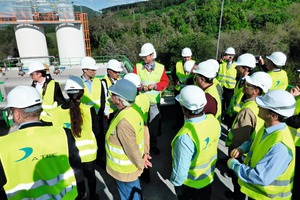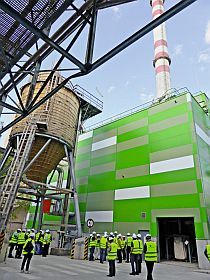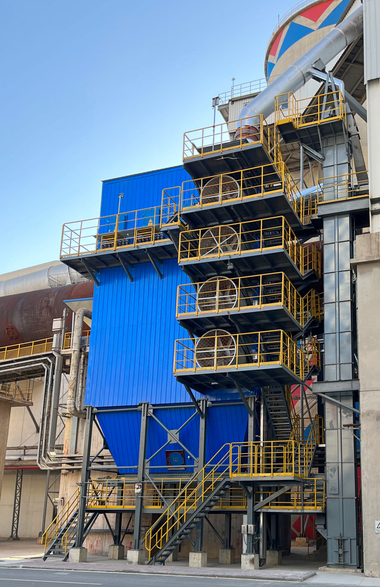The ReduDust process –
production of salt in the cement plant
The cement plant at Rohožník/Slovakia has developed the ReduDust process jointly with plant engineer A TEC, and thus constructed, in the truest sense of the word, it is a green system for removal of chlorine. In this environmentally friendly zero-waste process, the chlorine content of the bypass dust yielded is minimised to such an extent that this dust can subsequently be reused in the process. Industrial salts are the resultant useable product. We spoke to Dr. Ernst-Michael Sipple (48), ONEurope’s Environmental Coordinator, Holcim Emerging Europe Services, on the challenges encountered in implementing this project and on the results achieved.
SIPPLE: There are, in principle, two entry routes for chlorine at a cement plant. It may originate from the feed materials, or from the alternative fuels. Input with the feed materials basically only occurs if the quarry has been impregnated with salt water, which happens, typically, in sedimentary deposits near the coast, where salt water is present in the quarry. This is the case, for example, at our cement plants in Spain and Germany, and is, in fact, precisely the reason that we have long had the bypass dust treatment systems that you mention operating there. The salt water yielded, cleansed of heavy metals, is discharged into the anyway saline seawater without any ecological harm.
The use of alternative fuels in cement plants has repeatedly increased in recent times, from an initial 20 % to around 80 % at present, in individual plants, the target being 100 %. The importation of chlorine from alternative fuels has also increased continuously, however, and is now a fundamental problem! SRF (solid recovered fuel), usually a mixture of paper, cardboard, wood, plastics and also food scraps – in principle, everything occurring industrially as waste – is frequently used as the fuel mix. In Europe, this SRF mix has a chlorine content of around 0.5 to 1 %. This means, based on a rough calculation: a modern kiln needs approx. 3 to 4 GJ/tClinker. Coal, a traditional fuel, typically has a heating value of 30 to 40 GJ/t. The figures are simple, when alternative fuels of an order of magnitude of, let’s say, 20 GJ/t, are now used. 100 % use of alternative fuels means: for 10 t of clinker, I need 2 t of SRF, i.e., 20 kg of chlorine and 2 kgChlorine/tClinker. The limit is 0.1 %, but here I’ve got 0.2 % chlorine. When such high levels of SRF are used in the fuel mix, a chlorine bypass is installed, and large quantities of bypass dust are yielded, but can no longer simply be “accommodated” in the product as they used to be. So what we are to do with these large quantities of chlorine-containing dust – amounting, at Rohožník, to no less than 10 000 t per year? Landfill dumping is not an option, because it’s much too expensive and, in the long term, will anyway not be possible in Europe. Therefore, we wanted to find a practicable and also an ecological solution, so we firstly looked to see if we could buy such a system, but we soon realised that what we wanted was not available in the form we wanted. The individual stages are available, in some cases, but there are no turnkey suppliers. We, at Holcim, already had experience with the wet bypass dust washing process, and basic knowledge of it, so we discussed with plant engineers A TEC what could be done, and this resulted in the development of the ReduDust process.
SIPPLE: The wet bypass dust treatment system we’ve mentioned cannot be used in inland regions, since water containing salt cannot simply be discharged into the groundwater. That was the origin of our idea of recovering salt as an end product by means of an evaporation and crystallisation process. This, in fact, is a very simple and known process. The challenge for us was to implement it in a cement plant and to achieve an ideal combination of the individual process stages.
Now only around 5 t of residual material requiring disposal, and KCl, as a high-quality product, are yielded as a result, instead of the previous 10 000 t of bypass dust. The salt not only has a higher value than a tonne of the cement produced, it is also REACH registered. The annual quantity of around 4000 t produced is of particular interest for the local agricultural market.
SIPPLE: The reason is that a four-stage full-package system incorporating all safety provisions was built as a pilot plant at Rohožník. It will be possible to design future plants much more simply. The overall system was designed to be so safe that typical chemicals hazards are excluded. These provisions include, for example, all substances being stored in separate tanks and, in some cases, even in separate rooms. Mistakes of identification can thus be excluded from the start. All reactions take the form of a descending cascade – in other words, nothing can flow backwards. Safety was an extremely important priority for us, since we built this “chemicals plant” into an existing cement plant, and also because the process is operated by cement plant personnel.
The really good thing about the process we’ve developed is the fact that it’s possible to evolve a range of different modules based on one another, and that it can be done more and more simply. We didn’t want that for the pilot project, however. The pilot plant had to incorporate the complete step-by-step process. That’s also the basis of our know-how, the reactions that take place are standard – but how they take place is our special knowledge, and we’ve also filed a patent for it.
We developed this system in the context of an extremely well-functioning joint project with A TEC. This was a very constructive and open cooperation right from the start, a genuinely highly positive experience for us.
SIPPLE: Yes, we’re extremely satisfied with the system, it’s running just as it was designed to do. Design throughput was achieved soon after start-up. One advantage we had was the fact that we’d already obtained a lot of knowledge in preliminary trials and tests, and this resulted in an ideal design for the system.
SIPPLE: Investment amounted to around 10 million €. The system is 100 % overdimensioned, it has a capacity of 20 000 t, because it was planned, from the start, to also process dust from other cement plants. That’s why the facility is installed on the site of the cement plant, but is fed, even with the plant’s own dust, from bulk tanker vehicles. The individual parts, such as the filter presses, the crystalliser and the pump system, are all tried and proven standard components, which we have cleverly combined with each other. Our know-how is in the development of the process. Treatment of this dust avoids landfill dumping costs, and the salt can be sold. And this system achieves yet another degree of freedom for cement production, because it’s now possible to use 100 % SRF as the fuel without generating bypass dust that has to be brought to a wast depony.
The system itself requires less maintenance than we usually expect in the cement industry. There are no major downtimes, for example. The “classical” maintenance intervals apply in the case of the mixers and filters. The cement plant’s responsible personnel also perform the servicing and maintenance work on this system.
SIPPLE: That’s absolutely right! We selected extremely experienced staff from the cement plant for this, and also instructed and trained them correspondingly in the new process engineering technology, the chemical risks and system maintenance. This very largely fully automated system is also monitored by the staff in the central control room, and is operated by one person per shift plus one additional member of staff per day. A good tip is the fact that it is, of course, an advantage to have a skilled worker from a chemicals plant for this, who will be able to accelerate daily optimisation.
SIPPLE: A TEC has taken over the test container and will certainly offer it to interested cement plants. Holcim had a team involved in the planning and development of the process, but does not manufacture this system. That’s now entirely A TEC business.
SIPPLE: In principle, it’s the same as a Lego set. Every cement producer can purchase the modules he needs. The system can be adapted extremely flexibly to the various conditions, requirements and legislation around the world and it can also be used in other industries where dusts are produced.
SIPPLE: The system installed at Rohožník is essentially extremely complex, because it is the first installation of this kind and was built to have a maximum flexibility to test and adjust the process. Optimisation here really means simplification. It would be perfectly possible, however, to add a third crystallisation stage, for example, and then also produce not only KCl and the KCl + NaCl mixed salt, but also straight NaCl, in a further stage.
SIPPLE: This is a concept that combines ecological and economic benefits. It enables cement producers to replace traditional fuels 100 % with alternative fuels, in particular SRF without generating waste bypass dust. This makes an important contribution to environmental protection and to sustainable, resource-conserving production. The system was conceived from the start in such a way that, in principle, no waste fraction is generated. The major portion of production costs are for evaporation of the water, and this energy is obtained 100 % from the waste heat from the kiln. In other words, the ReduDust system operates when the cement plant is operating. There is, in addition, practically no waste water, since the water is recirculated and is ultimately evaporated.







